Kakadu has World Heritage Status due to it’s breathtaking natural beauty and it’s ancient cultural heritage. Come and discover Kakadu’s world famous rock art galleries. Stand high above flood plains, on rugged rock formations, to watch an amazing sunset. See the stunning bird life on a tour of the wetlands, and of course crocodiles; or fish for Barramundi. Walk to lookouts and enjoy the local flora and fauna. There are so many things to do in Kakadu. Here are just some highlights.
For us as retirees enjoying travel in the Northern Territory, Kakadu was always on our bucket list. Neither of us had visited Kakadu before, so we were excited to see if it lived up to it’s reputation. Here’s what we found.
Kakadu National Park
Kakadu and neighbouring Arnhem Land are referred to as the timeless land. The ancient sandstone plateau and escarpments dramatically stand out against the bush land and forest areas. Then there is the beautiful wetlands, with rivers, billabongs and floodplains. The landscape has such diversity and beauty to enjoy.
Kadau has World Heritage status. Today, Kakadu is jointly managed by Bininji / Mungguy and Parks Australia. They work together to protect the outstanding World Heritage cultural and natural values of Kakadu. Some of the world’s best preserved rock art is found within Kakadu and is up to 20,000 years old.
The Kakadu National Park covers nearly 20,000 square km. Therefore, you can be travelling long distances within the Park.
Make sure you get a Kakadu National Park Holiday Planner. This planner provides a map of all the great things to do in each area of the park. The Planner is readily available in the park.
We bought a Kakadu Park Pass before entering the Park. A concession pass is available. As retirees enjoying travel we appreciate any seniors concessions, wherever they are available.
Roads are accessible by 2WD, unless otherwise advised. There were 34 road closures within the Park during our visit in early May 2017. You may think we saw nothing, but that is far from the truth. We were told the wet season had been a “big wet” (very wet). Even so, we were delighted with all we saw in Kakadu.
Call into Park Headquarters when you visit Kakadu for up to date information about what is accessible.
May to September are the most popular times for tourists to travel in Kakadu.
Yellow Water Fishing Tour
As a keen fisherman, Greg has wanted to go Barramundi fishing for years. So the Yellow Water Fishing tour was a must.
We booked the 3 hour fishing tour at the reception Cooinda Resort.
Road access to the Yellow Water Billabong was closed to the general public, as there was a lot of low lying water across the road. A bus transported us to the boat by 6.45am..
We were excited to be going out onto the Kakadu world famous Yellow Water Billabong. Being on the billabong, as the sun is rising, is an unreal experience. The natural beauty of the area, the water views, the bird life, the fish jumping… It surely cannot get any better. It is simply breathtaking scenery. If you visit Kakadu, the Yellow Water Cruises is a must.
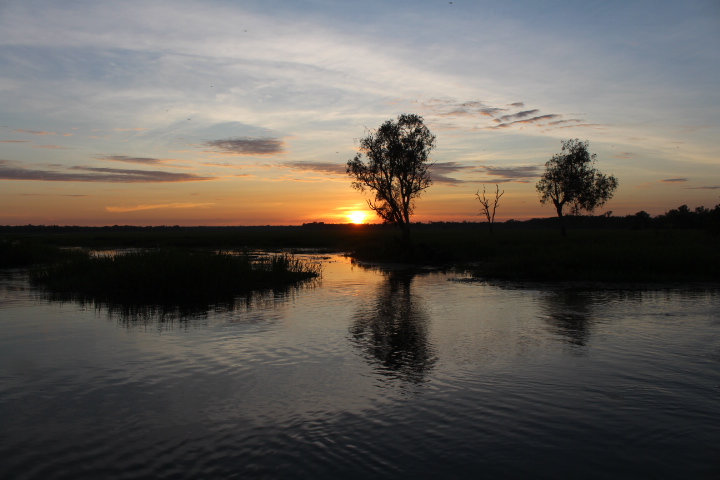

But for Greg, it was all about the fishing.
During the three hour fishing tour everyone together probably pulled in about twenty Barramundi. But the only one to land a keeper (Barramundi 55 cm or over) was our very experienced tour operator Rob.
The Yellow Water Fishing tour only takes four passengers. Therefore the boat was a roomy and safe fishing environment. Rob provided fabulous guidance about what lures to use, where to cast our lines, techniques on attracting the Barramundi, as we reeled our line in. And, he helped to net any fish caught. Rob was truly an attentive and patient fishing tour guide.
To top this off, Rob donated the keeper he caught. We were very lucky to be the recipients of Rob’s kind gift. Rob even filleted the fish for us. How great was that!
Needless to say, we did not catch a keeper. So, along our travels, I think there will be another Barramundi fishing trip one day.
But, I was the paying passenger who caught the largest Barramundi – 52cm! It was released back into the water.

Yet, for me, I was simply blown away by the scenery of the Yellow Water Billabong.

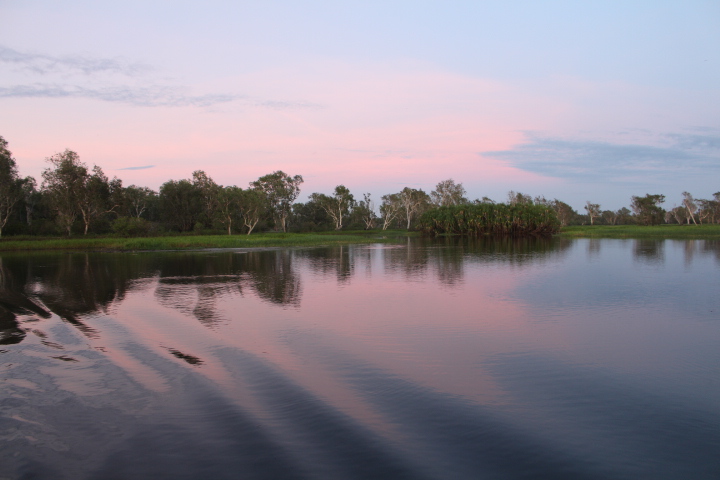

Another fantastic experience is seeing a crocodile in their natural wetland environment. Everyone on the fishing boat became so excited to see a huge male crocodile slowly swimming along the billabong towards us. Of course, we all stopped fishing and began taking photos. It was massive. But as the crocodile neared the boat, it submerged. Several minutes later we saw it swimming away, on the other side of the boat. What an experience!


We saw several other crocodiles, but none as large as the first crocodile sighted.
Throughout the Park there a warning signs about the danger posed by estuarine (Saltwater) crocodiles. The big message is to assume there are crocodiles in or near the water. So, do not get in the water, or stand near the waters edge. Crocodiles within the Park have caused severe injuries and death.
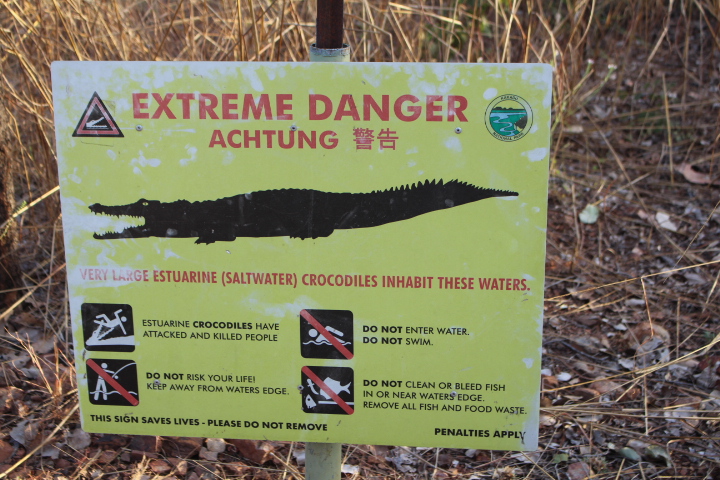
Lotus lilies make a delightful spectacle on the freshwater billabongs.

The wetlands is a haven for bird life. Over one third of Australian bird species can be found in the Kakadu.
Visit Ubirr for Rock Art & Stunning Sunset
A visit to Ubirr is another must to put on your travel list. Ubirr is where you can see ancient Aboriginal rock art, plus an unforgettable sunset from atop wonderful rock formations.
We were told the road to Ubirr had water over the road in two places. Yet, it was accessible by a high clearance vehicle if the water level was 0.4 m or below, which it was. Fortunately, the water crossings were very easy.
We arrived at Ubirr at about 4pm. Firstly, we visited the wonderful displays of Aboriginal rock art.
Ubirr is one of the most famous Aboriginal rock art galleries in Kakadu. We did a self guided tour and this took about an hour.
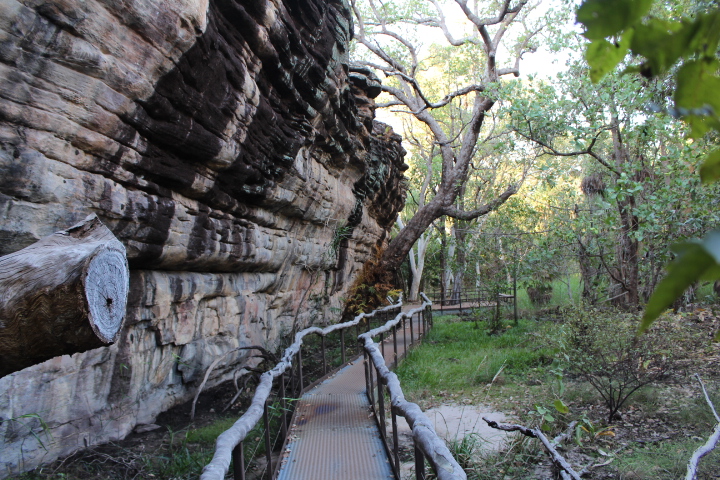
Along this walkway we enjoyed viewing the rock art painted onto the rock wall.

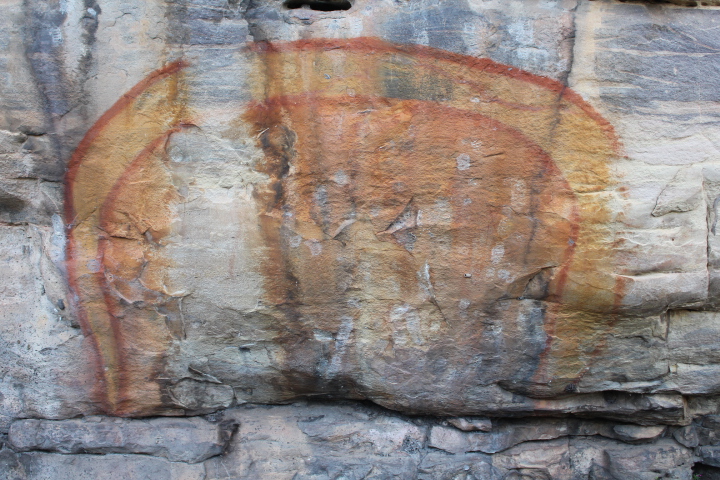
Then we, with many other tourists, climbed to the top of Ubirr, to await the sunset. From this high vantage point we enjoyed spectacular panoramic views of the surrounding floodplains and rugged cliffs of the Arnhem Land escarpment.
Golden light highlighted the wonderful colours of the landscape.

In fact, everything took on the golden light of the sun as it was setting.

The walk to the rock platform, to watch the sunset, took us about a half hour.

The climb towards the end of the walk is steep. As you can see in the picture above, we still had to climb up to the top (where the person is standing, near my head in the picture). There are no rails, and in spots, we found it a little difficult. But for retirees, we thought we did pretty well. We weren’t the only retirees who made the climb. There were lots of baby boomers up on top busy taking photos, just like us.
If you do not want climb to the top, you can still get get views of the sunset from the platform we are standing on. This section of the climb is not as difficult. A number of people set up there cameras to shoot the sunset from here.

But, there was quite a crowd at the top. Everyone settled in to enjoy the scenery and watch the sunset. Interestingly, the crowd was mainly young back packers and retirees; both generations enjoying travel in outback Australia.

The rock platform is high above the floodplain. And oh what a view. And oh what a beautiful sunset.
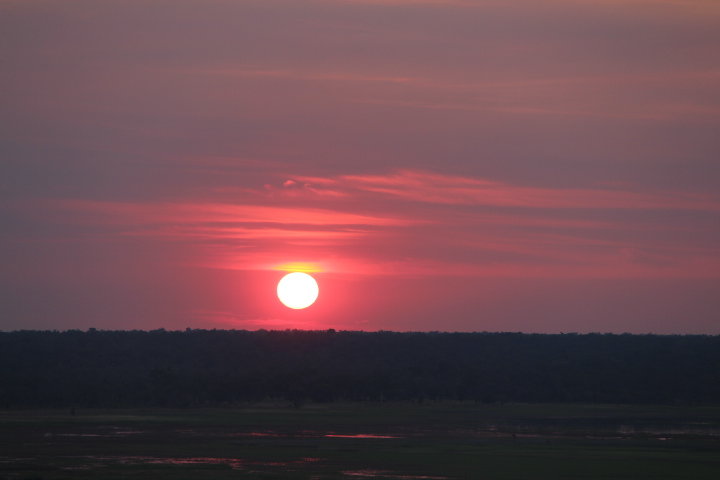
Rock Art at Anbangbang Gallery
Another one of the famous Aboriginal rock art Galleries in Kakadu is the Anbangbang Gallery.
Access to the Anbangbang Shelter and Gallery are via steps and a board walk. Initially, some steps are steep.
The Warramal clan’s ancestor’s considered the Anbangbang shelter to be a place for living and learning.
In the photo below you can see the huge Anbangbang shelter. The boardwalk and story enables tourists to read about the rock art they are seeing.


The Anbangbang Gallery is where we saw ancient aboriginal rock art on the Anbangbang shelter walls.

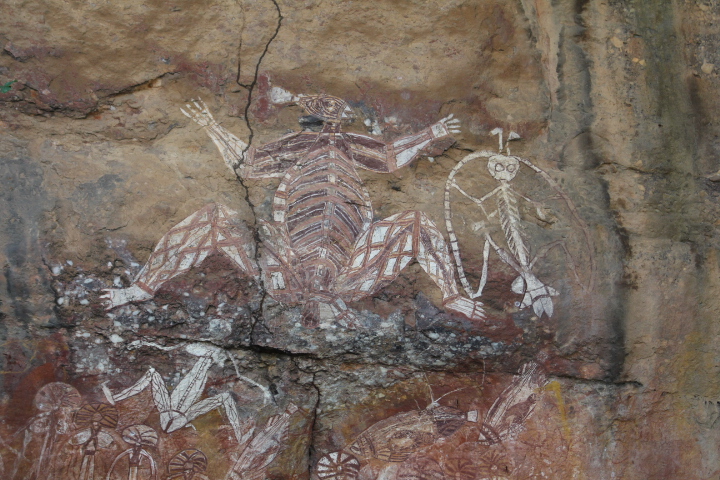
We saw rock art of Namarrgon, the lightning man.

From the rock art gallery we walked up to the Gun-warddehwarde Lookout and looked across to the Arnheim Land escarpment.

Prior to visiting Anbangbang we walked up to the Mirrai Lookout. This is a 1.6km walk, and it is graded as steep. There were lots of rocks on the walking path, and at times we had to be careful where we placed our feet. Mind you Greg powers on. But, now as a baby boomer, I find myself being more careful than I used to be on uneven surfaces. Having said that, I am very capable of walking wherever.

There are multiple lookouts in Kakadu. We walked up many to enjoy the views. For retirees enjoying travel, this is certainly one way to keep fit. Indeed, we believe these steep climbs have helped improve our level of fitness.
Warradjan Aboriginal Cultural Centre
We really enjoyed our visit to the Warradjan Aboriginal Cultural Centre. This centre features cultural information, spanning more than 50,000 years, as interpreted by the Bininj / Mungguy Aboriginal people. We found the display tastefully done and very informative.
Camp grounds
We travelled into Kakadu National Park from the Pine Creek road entrance.
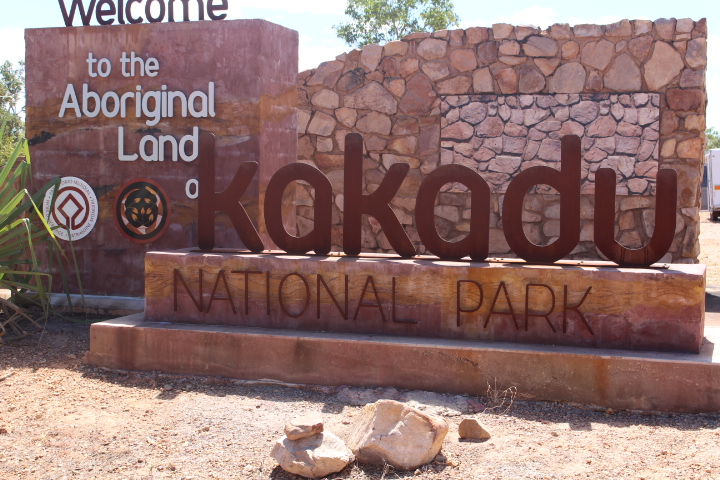
One of the first things we saw were giant ants nests.

We were in Kakadu five days, four nights.
The first night we stayed at Gungural. At this camp ground you need to be self sufficient. There are toilets and picnic tables.
We enjoyed an early morning walk to the lookout from this camp-site.
For the next two nights we travelled on to Cooinda Campground and Caravan Park, near the Yellow Water Billabong. This was a wonderful place to stay. The camp ground was shady and there was plenty of green grass.
We just loved the swimming pool. Each day we went out sightseeing early. Then, we would return to Cooinda and enjoy getting into the pool several times in the afternoon. It was 33 and 34 degrees during our stay. So sitting around the pool during the afternoon heat was the best.

For the third night we travelled to Jabiru and stayed at the Kakadu Resort. This again was a lovely camp ground with shady trees and nice green grass.
Tip
Make sure you pack mosquito repellent. During our stay in Kakadu there were many mosquitoes. Mosquito repellent was very expensive to purchase at the resort.
Jim Jim Falls and Twin Falls region
We naively thought we would be travelling out to see the famous Jim Jim Falls and the Twin Falls in Kakadu. What we didn’t realise is the road is 4WD. We were told the road was heavily corrugated. Also, this trip takes 2 hours travelling time one way. Then, there is a one km walk over rocks to the base of the falls. If you have the money, a scenic flight by helicopter or aeroplane sounds the best option to enjoy the waterfalls.
But, perhaps you would enjoy an adventure tour, to see the less accessible parts of Kakadu.
For us as retirees enjoying travel, Kakadu did live up to it’s reputation. Initially, we were disappointed we didn’t see Jim Jim Falls and the Twin Falls. But, everything else was wonderful. We enjoyed fabulous bush walks, with majestic views from lookouts. The scenery is truly stunning. The tour on the wetlands and the visits to the rock art galleries were our favourite things to do. So, overall, we enjoyed a fantastic time.
Bring your money with you if you plan to do a number of tours. Also, we found shopping for food and personal items expensive in the park. So stock up before you come.
All in all, we totally recommend a visit to Kakadu.
Safe travels
Cheers from Estelle and Greg – Retirees Enjoying Travel
